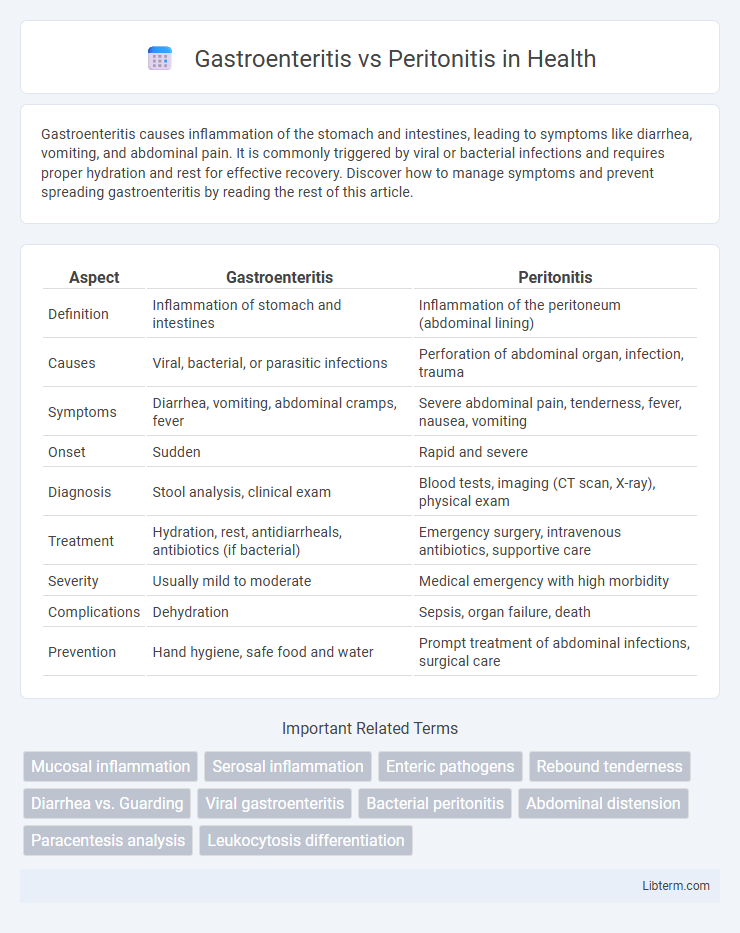Gastroenteritis causes inflammation of the stomach and intestines, leading to symptoms like diarrhea, vomiting, and abdominal pain. It is commonly triggered by viral or bacterial infections and requires proper hydration and rest for effective recovery. Discover how to manage symptoms and prevent spreading gastroenteritis by reading the rest of this article.
Table of Comparison
| Aspect | Gastroenteritis | Peritonitis |
|---|---|---|
| Definition | Inflammation of stomach and intestines | Inflammation of the peritoneum (abdominal lining) |
| Causes | Viral, bacterial, or parasitic infections | Perforation of abdominal organ, infection, trauma |
| Symptoms | Diarrhea, vomiting, abdominal cramps, fever | Severe abdominal pain, tenderness, fever, nausea, vomiting |
| Onset | Sudden | Rapid and severe |
| Diagnosis | Stool analysis, clinical exam | Blood tests, imaging (CT scan, X-ray), physical exam |
| Treatment | Hydration, rest, antidiarrheals, antibiotics (if bacterial) | Emergency surgery, intravenous antibiotics, supportive care |
| Severity | Usually mild to moderate | Medical emergency with high morbidity |
| Complications | Dehydration | Sepsis, organ failure, death |
| Prevention | Hand hygiene, safe food and water | Prompt treatment of abdominal infections, surgical care |
Introduction to Gastroenteritis and Peritonitis
Gastroenteritis is an inflammation of the stomach and intestines, typically caused by viral, bacterial, or parasitic infections leading to symptoms like diarrhea, vomiting, and abdominal cramps. Peritonitis involves inflammation of the peritoneum, the membrane lining the abdominal cavity, usually resulting from bacterial infection due to perforation or injury, causing severe abdominal pain and systemic infection. Both conditions affect the gastrointestinal system but differ in etiology, clinical presentation, and severity, requiring distinct diagnostic and treatment approaches.
Definition and Overview
Gastroenteritis is an inflammation of the stomach and intestines, commonly caused by viral, bacterial, or parasitic infections, leading to symptoms such as diarrhea, vomiting, and abdominal cramps. Peritonitis is the inflammation of the peritoneum, the lining of the abdominal cavity, often resulting from infection due to a perforated organ, trauma, or surgery, and presents with severe abdominal pain and tenderness. Both conditions require prompt medical attention but differ significantly in cause, severity, and treatment approaches.
Causes and Risk Factors
Gastroenteritis primarily results from viral infections such as norovirus and rotavirus, bacterial pathogens like Salmonella and E. coli, or contaminated food and water, with risk factors including poor sanitation, close contact with infected individuals, and travel to endemic areas. Peritonitis typically arises from bacterial infection following a perforated abdominal organ, such as appendicitis, diverticulitis, or gastrointestinal trauma, with increased risk linked to abdominal surgery, chronic illnesses like liver cirrhosis (ascites), or peritoneal dialysis. Both conditions pose significant health risks, but their causes and predisposing factors vary distinctly based on the underlying pathology and exposure routes.
Key Symptoms and Clinical Presentation
Gastroenteritis primarily presents with symptoms such as diarrhea, vomiting, abdominal cramps, and fever, often accompanied by dehydration and malaise. In contrast, peritonitis is characterized by severe abdominal pain, tenderness, rigidity, fever, and signs of systemic inflammation like tachycardia and hypotension, indicating an acute abdominal emergency. While gastroenteritis affects the gastrointestinal lining causing inflammation of the stomach and intestines, peritonitis involves inflammation of the peritoneum, often due to infection or perforation, necessitating urgent medical intervention.
Diagnostic Differences
Gastroenteritis is typically diagnosed through clinical evaluation of symptoms such as diarrhea, vomiting, and abdominal cramps, often supported by stool cultures or viral antigen tests to identify infectious agents. Peritonitis diagnosis relies on physical signs including abdominal rigidity, rebound tenderness, and severe pain, with confirmation through laboratory analysis of peritoneal fluid obtained via paracentesis, showing elevated white blood cell counts or presence of bacteria. Imaging studies like abdominal ultrasound or CT scans play a crucial role in differentiating peritonitis by revealing inflammation or fluid accumulation in the peritoneal cavity, which is not present in gastroenteritis.
Complications and Severity
Gastroenteritis typically causes mild to moderate dehydration and electrolyte imbalances, with complications more common in vulnerable populations such as children and the elderly. Peritonitis is a severe, life-threatening inflammation of the peritoneum often resulting in sepsis, organ failure, and requires urgent medical intervention. The prognosis of peritonitis is significantly worse than gastroenteritis due to its rapid progression and systemic impact.
Treatment Options
Gastroenteritis treatment primarily involves rehydration with oral or intravenous fluids to prevent dehydration, alongside electrolyte replacement and symptom management using antiemetics or antidiarrheals. Peritonitis requires urgent medical intervention, including broad-spectrum intravenous antibiotics and often surgical procedures like laparotomy to address underlying causes such as perforation or infection. Both conditions necessitate close monitoring, but peritonitis generally demands more intensive and immediate treatment to prevent sepsis and complications.
Prevention Strategies
Effective prevention of gastroenteritis relies on rigorous hand hygiene, safe food handling practices, and vaccination against rotavirus and norovirus. Peritonitis prevention emphasizes sterile techniques during abdominal surgeries, timely treatment of intra-abdominal infections, and careful management of peritoneal dialysis catheters. Both conditions require awareness of risk factors and early intervention to minimize complications and transmission.
Prognosis and Recovery
Gastroenteritis typically has a favorable prognosis with full recovery expected within days to weeks, especially when properly hydrated and treated symptomatically. Peritonitis, however, carries a more severe prognosis requiring prompt surgical intervention and intensive antibiotic therapy to prevent life-threatening complications and improve survival rates. Recovery from peritonitis is prolonged and may involve hospitalization, while gastroenteritis usually resolves quickly without long-term consequences.
When to Seek Medical Attention
Severe abdominal pain, persistent vomiting, high fever, or signs of dehydration indicate the need for immediate medical attention in cases of gastroenteritis or peritonitis. Peritonitis often presents with rigid abdomen and worsening symptoms that require emergency care due to potential life-threatening complications. Gastroenteritis symptoms that worsen after 48 hours or are accompanied by blood in stool or severe abdominal cramping also warrant prompt evaluation by a healthcare professional.
Gastroenteritis Infographic

 libterm.com
libterm.com